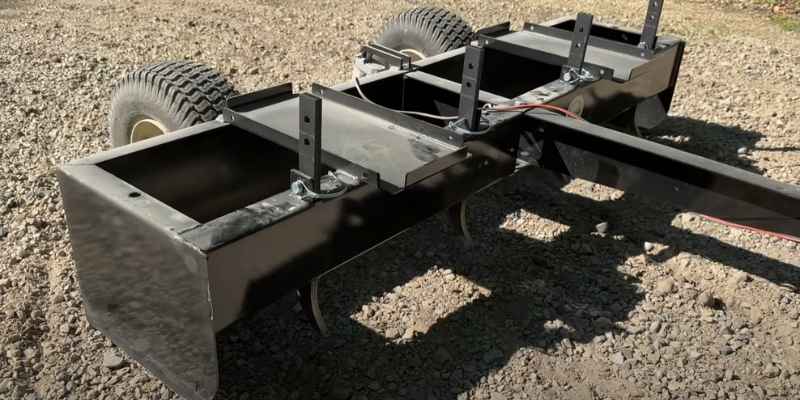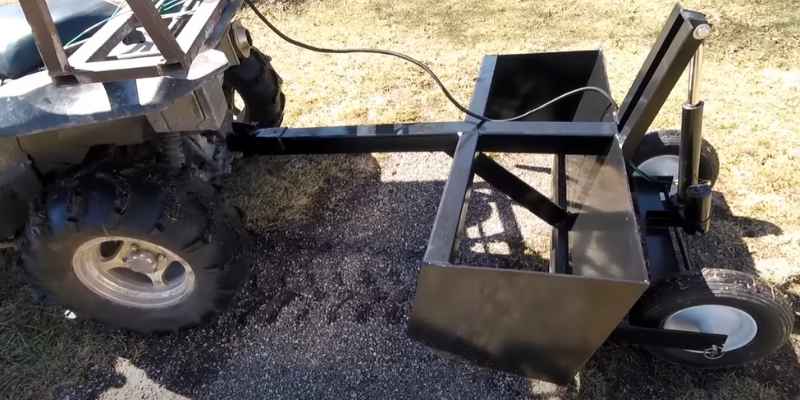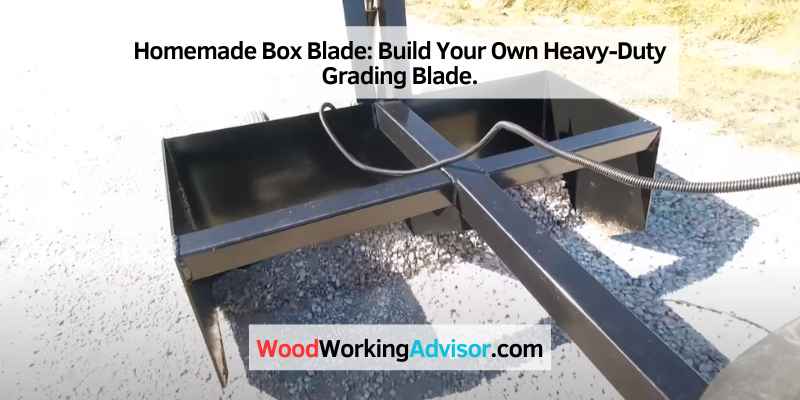A homemade box blade is a DIY attachment for leveling and grading soil or removing debris. It can be used with a tractor or an ATV.
A box blade is an essential attachment for a tractor or an ATV. It is used for various outdoor projects like leveling the ground, removing debris, grading soil, and backfilling. However, purchasing a high-quality box blade can be expensive. That’s why some people opt to build their own homemade box blade instead of buying one.
Homemade box blades are typically cost-effective and simple to construct. They can be customized to fit your specific needs and are easy to attach to your vehicle. We will explore what a homemade box blade is, how you can make one, and its various applications.

Choosing The Right Box Blade
Choosing the right homemade box blade for your lawn tractor or ATV can be a challenging task. Look for features like the width of the blade, hitch type, and blade angle adjustment, to ensure that you get the best box blade for your needs.
Do your research and consider your budget to find the perfect homemade box blade.
Tractor Width And Box Blade Size
When it comes to choosing the right box blade, the size of your tractor plays a crucial role. The box blade you choose should be slightly wider than the tractor tires to ensure efficient leveling, grading, and backfilling. Typically, box blade sizes range from 4 feet to 8 feet. However, always consider the weight of the box blade before getting one. If you have a small tractor, then it’s best to stick with a smaller box blade to prevent overloading your tractor, which can impact its performance and affect the quality of the job.
Horsepower Requirements
Before choosing your box blade, you need to consider the horsepower of your tractor. The horsepower of your tractor determines the type of box blade you need. Generally, the heavier the box blade, the more horsepower you need. A tractor that ranges between 15 and 30 horsepower that has a smaller PTO, can handle a box blade of 4 feet up to 5 feet. On the other hand, a larger PTO with 30-50 horsepower range can handle up to a box blade of 6 feet up to 8 feet long.
When choosing a box blade, consider its functionality and weight so that it meets your needs. A bigger box blade may seem ideal, but it can be challenging to handle and come with horsepower requirements that your tractor may not possess.
When purchasing a box blade, look for one that works well with your tractor size, has durability, and can perform the intended task effectively. With the right box blade, you get the job done efficiently, saving you time and money.
Building A Box Blade From Scratch
Building a box blade from scratch is a great project for those looking to save money and have a homemade tool that meets their specific needs. With the right materials and some basic welding skills, you can make a functional and durable homemade box blade for your tractor or ATV.
If you are a property owner looking to do some grading or leveling, then a box blade is an ideal option for you. A box blade is an attachment that can be connected to a variety of vehicles, including lawn tractors, garden tractors, ATVs, and four-wheelers, to name a few. These attachments are available to purchase commercially, but if you are someone who loves a good DIY project, then building your own box blade from scratch is entirely possible. In this article, we will explore the materials needed and step-by-step instructions to build a homemade box blade.
Materials Needed
Before you begin building your homemade box blade, gather the following materials:
- 2×4 steel tubing (4 pieces, 6ft long)
- 1/4-inch steel plate (4 feet long, 3 inches wide)
- Metal cutting saw
- MIG welder
- Grinder
- Paint
- Hardware (bolts, nuts, washers)
Step-by-step Instructions
Follow these step-by-step instructions to build your homemade box blade:
- Cut the 2×4 steel tubing into the following sizes: two pieces at 5 feet long, two pieces at 3 feet long, and six pieces at 1 foot long.
- Weld the 1-foot pieces to the end of each 5-foot piece, and the 3-foot pieces to the end of each 5-foot piece, forming a rectangular frame.
- Cut the 1/4-inch steel plate into six pieces measuring 1-foot long, with a 45-degree angle on each end.
- Weld each of these pieces to the bottom of the rectangular frame, spacing them about 1 foot apart from each other.
- Cut a small piece of steel plate and weld it to the center of the frame, creating a hitch point for your vehicle.
- Clean the entire frame and plate with a grinder, removing any rough edges or excess metal, and paint it to protect it from rust.
- Attach your hardware to the box blade, including bolts, nuts, and washers, ensuring they are tight and secure.
Building a homemade box blade from scratch is an excellent way to save money and create a unique attachment that meets your property’s specific needs. With the right materials and a little time and effort, you can have a highly functional homemade box blade that will make your grading and leveling tasks a breeze.
Using A Box Blade
A homemade box blade can be an efficient tool for grading, leveling, and backfilling your property. It can be built from materials lying around and customized according to your needs. Check out various online resources for DIY box blade tutorials and designs.
Are you tired of uneven surfaces on your property? A box blade can be your solution to that problem. Many people use box blades for leveling the soil, grading in landscaping projects, and clearing debris from their land. A box blade is a heavy-duty attachment that can be attached to your tractor, ATV, or UTV, making it multi-purpose equipment.
Tips And Techniques
Using a box blade requires a bit of technique to achieve the best results. Here are a few tips to help you maximize its effectiveness:
- Adjust the blade’s height according to the surface you are working on. Lower the blade for digging and raising for smoothing the soil.
- Take your time and go slowly — don’t rush.
- Use the box blade’s ripper teeth to loosen up the soil before grading it.
- Overlap the passes during each round to ensure smoothness and level surfaces.
- Always check for debris on the ground before starting the job.
Common Applications
A box blade can be used in many applications. Here are a few common ones:
| Application | Description |
| Grading | The box blade can level uneven surfaces, making the soil more manageable. |
| Driveway Maintenance | If you have a gravel driveway, then the box blade can be an effective tool to grade the surface. |
| Landscaping | The box blade can be used to smooth the soil to prepare it for planting flowers, grass, or trees. |
| Clearing Debris | The box blade can drag debris like branches, rocks, etc. from your yard or land. |
In conclusion, the box blade is a versatile attachment that can help you in many applications. With the above tips and techniques, you can get amazing results from your box blade, no matter the task at hand.

Frequently Asked Questions For Homemade Box Blade
What Is The Difference Between A Box Blade And A Box Scraper?
A box blade and a box scraper are two different blades used for ground work. The main difference is that a box blade has ripper shanks and is used for heavy-duty jobs, while a box scraper is used for lighter jobs like removing debris.
What Horsepower Do You Need For A Box Blade?
The horsepower required for a box blade varies based on the size of the equipment. It is recommended to choose a box blade with a horsepower rating that matches or exceeds the horsepower of your tractor.
Are Box Blades Worth It?
Yes, box blades are worth it. They are a versatile attachment that can help with leveling, grading, removing ruts, breaking up compacted ground, and backfilling. They work well for projects around your property and can be used with tractors of different horsepower.
When buying a box blade, look for one that’s slightly wider than your tractor and has clevis hitches for stronger attachment.
Does A Box Blade Need To Be Wider Than Tractor?
A box blade should be slightly wider than the tractor tires. To be safe, measure the width of your tractor and purchase a box blade that is a little wider. Look for clevis hitches as they are stronger than pin hitches.
A box blade is a versatile attachment for grading, leveling, breaking up compacted ground, and backfilling.
Conclusion
A homemade box blade is a viable DIY solution for those seeking to level their property or perform grading activities. With the right materials and tools, anyone can build a functional box blade themselves, as evidenced by numerous online tutorials and DIY forums.
A homemade box blade may require more effort to build, but it can save on costs and be customized to specific needs. No matter the type of box blade used, it can improve property value and make landscaping projects easier.


